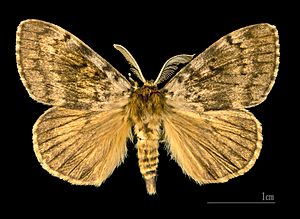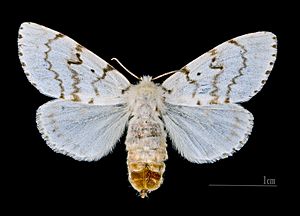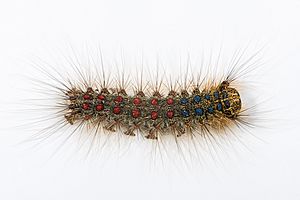Spongy moth facts for kids
Quick facts for kids Spongy moth |
|
|---|---|
 |
|
| Mounted Lymantria dispar dispar male | |
 |
|
| Mounted Lymantria dispar dispar female | |
| Scientific classification | |
| Genus: |
Lymantria
|
| Species: |
dispar
|
| Subspecies | |
|
L. d. dispar |
|
| Synonyms | |
|
|
The Lymantria dispar, also known as the spongy moth, is a type of moth found in Europe and Asia. It belongs to the family Erebidae. There are different kinds, or subspecies, of the spongy moth, like L. d. dispar and L. d. japonica. These can be easily told apart.
The spongy moth has spread to many parts of the world. You can now find it in Europe, Africa, Asia, North America, and South America. Its young, called larvae or caterpillars, eat leaves from many different kinds of trees. They eat both trees that lose their leaves (deciduous) and evergreen trees (coniferous). When there are many moths, their caterpillars can cause a lot of damage to forests. Because of this, the spongy moth is listed as one of the world's 100 worst invasive alien species.
Contents
What's in a Name?
The name Lymantria dispar comes from two Latin words. The first part, Lymantria, means 'destroyer'. This makes sense because the caterpillars can destroy trees.
The second part, dispar, means 'to separate' or 'different'. This refers to how different the male and female adult moths look. This difference between males and females is called sexual dimorphism. For example, females are usually larger and lighter in color than males.
Spongy Moth Types (Subspecies)
The spongy moths found in North America and Europe are usually considered the same type, called Lymantria dispar dispar. Sometimes, there is confusion about how to classify these moths. For example, the U.S. Department of Agriculture describes the Asian types as any spongy moth where the female can fly. However, other types of Asian spongy moths can also fly.
Different Subspecies and Where They Live
| Subspecies | Where They Live | How to Identify Them |
|---|---|---|
| Lymantria dispar dispar | Native to Europe, western Asia, and north Africa. It was brought to Eastern North America. | Female moths have wings but cannot fly. |
| Lymantria dispar asiatica | Native to Eastern Asia. It has been brought to western North America and Europe. | Female moths have wings and can fly. They are also attracted to lights. |
| Lymantria dispar japonica | Found all over Japan. | Male moths are large and have a very dark brown color. |
The European spongy moth (Lymantria dispar dispar) naturally lives in the forests of western Europe. It was brought to the United States in 1869 and to Canada in 1912.
The Asian spongy moth (Lymantria dispar asiatica) naturally lives in temperate parts of Asia, east of the Ural mountains. Since the early 1990s, it has also been seen along the West Coast of North America. From Southern Europe, it is moving north into countries like Germany. There, it can mix with the European spongy moth, L. d. dispar. A group of these moths was even reported in Great Britain in 1995.
How We Control Spongy Moths
In North America, scientists have brought in other insects to help control the spongy moth. These insects are called biological control agents. They include parasitoids and predators. Parasitoids are insects that lay their eggs on or inside another insect, eventually killing it. Predators hunt and eat other insects.
Since the late 1800s, at least 10 different species of these helpful insects have become established. However, for a long time, there wasn't much research on how well they worked or if they harmed other native insects. Some of these introduced insects were not picky eaters. They attacked many different kinds of insects, not just the spongy moth.
The most effective ways to control the spongy moth are using tiny living things called microbial pathogens. These include a virus (called LdmNPV) and a fungus (called Entomophaga maimaiga). These pathogens can infect and kill the spongy moth caterpillars, helping to keep their numbers down.
See also
 In Spanish: Lagarta peluda para niños
In Spanish: Lagarta peluda para niños


